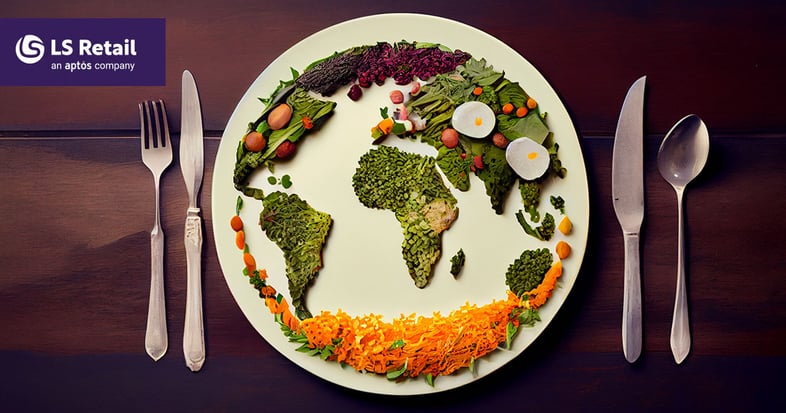Attract customers and cut costs by making your restaurants more sustainable

As environmental consciousness continues to grow among consumers, the impact is being felt in every industry. From solar-powered products to eco-friendly packaging, there has been a surge in demand for sustainable goods. Interestingly, consumers are willing to pay more for products that have a lower environmental impact. However, many restaurants have not yet adapted their practices to cater to this environmentally conscious audience. The good news is that going green doesn't have to be an all-or-nothing approach. Even if you can't afford major changes like installing solar panels or renovating your restaurant with recycled materials, there are still steps you can take to make your establishment more sustainable and appealing to environmentally-minded customers.
Here are some tips to help you get started:
Revamp the menu
Is your menu appealing to environmentally conscious consumers, or is it in need of a makeover? Making small changes to your dishes can go a long way in reducing waste and pollution while also attracting more customers.
Consider the origin of your ingredients. Instead of purchasing produce that has traveled long distances, opt for sourcing materials from local farms and producers. Not only will you have fresher ingredients, but you can also proudly display the provenance of your ingredients on your menu.
Highlight the additional attributes of your ingredients. If you purchase organic vegetables, fair trade coffee, or meat from farms with high animal welfare standards, make sure to mention it on your menu. And if you haven't yet incorporated any environmentally friendly ingredients, now is the perfect time to start exploring those options.
Cut the waste
Food waste is a significant issue plaguing the restaurant industry, with a staggering amount of waste ending up in the garbage can. According to the Green Restaurant Association, a single restaurant can generate between 11 and 34 tons of food waste in a year. However, there are several green strategies that can help reduce this waste:
- Keep a close eye on your inventory count on a daily basis to ensure you have the correct par stock levels. Ordering the right quantities will help minimize excess inventory and prevent food spoilage.
- Embrace the concept of root-to-stem cooking, which involves using all parts of your produce creatively. Don't discard leaves or peels when they can be transformed into delicious dishes like potato peel fries or pesto made with carrot tops. This approach not only reduces waste but also keeps you on-trend with the latest food trends.
- Implement a comprehensive management system that allows you to track and analyze your waste, including food, plastics, boxes, and more. This system will enable you to calculate your restaurant's environmental footprint, identify patterns of waste, and make necessary changes. For instance, if you notice that your staff is frying more chicken wings than are being sold on certain days, you can take actions to rectify the situation.
- Instead of throwing away leftover food at the end of the day, consider donating it to a food bank or another charity. This not only helps reduce food waste but also contributes to alleviating hunger in your community.
By implementing these green strategies, you can make a significant impact on reducing food waste in your restaurant while also aligning with the values of environmentally conscious customers.
Focus on efficiency
Energy-efficient appliances can reduce utility bills and should be considered when opening a new location or replacing old equipment. Regular temperature checks and Bluetooth-connected thermometers can help ensure efficient operation. Replacing incandescent lightbulbs with LED lights can lead to significant energy savings. Restaurants can also improve water efficiency by training employees to conserve water and regularly checking for leaks. Henderson's Restaurant in Edinburgh reduced water usage by 33%, resulting in estimated savings of €5,000 per year.Go homemade
In the food service industry, personalized and unique items have become a major trend in recent years. This trend extends to house-made items such as jams, pickles, mayonnaise, dressings, and snack mixes. By utilizing "ugly" or leftover ingredients, you can create one-of-a-kind flavors that not only enhance your brand but also reduce food waste. And if a particular item becomes popular with customers, why not produce more to sell? Offering a "Mama's restaurant" jar of spicy chutney is a fantastic way to stay in the forefront of customers' minds, even when they are enjoying a cozy meal at home.
Give up paper
Reducing paper waste in your business is not just an environmental concern, but it can also save you money. Here are some innovative ideas to help you minimize paper waste:
- Instead of printing out daily specials, showcase them on a stylish blackboard. This not only eliminates the need for paper but also adds a touch of charm to your restaurant.
- Offer e-mail receipts to your customers. This not only reduces paper usage but also allows you to gather valuable customer information for future marketing efforts.
- Invest in a Point of Sale system that seamlessly connects to kitchen display systems. This eliminates the need for printing out orders, saving paper and eliminating errors.
- When you do need to use paper, opt for recycled and FSC-certified paper sourced from responsibly managed forests. Consider printing your menus on recycled paper as well, demonstrating your commitment to sustainability and adding a unique touch to your restaurant.
By implementing these paper-saving strategies, you can showcase your eco-consciousness while also cutting costs and attracting environmentally-minded customers.
Don’t forget about the takeout
When it comes to offering takeout, it's crucial to showcase your commitment to the environment through your packaging choices. Say goodbye to polystyrene foam and plastic containers, which are harmful to the environment and give off an outdated image. Instead, opt for biodegradable packaging and utensils. For instance, consider providing paper straws instead of the highly polluting plastic ones. And remember, don't go overboard with the paper napkins. With two-thirds of consumers willing to pay more to support restaurants that prioritize sustainability, going green is not just an ethical decision but also a smart business move.
If you need help figuring out how the right management software solution can help you on the path to becoming greener, don’t hesitate to contact our experts.

Unlock success for you F&B chain with the right restaurant management software
